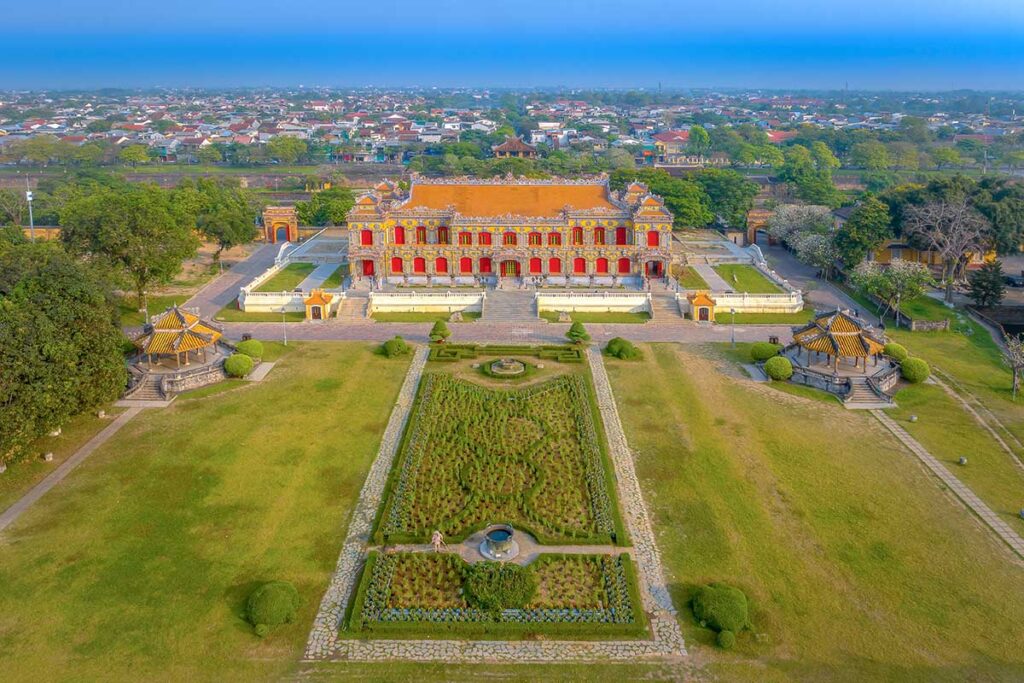Short history about the temples, pagodas and tombs in Hue
Hue, once the imperial capital of Vietnam under the Nguyen Dynasty (1802–1945), is home to a rich collection of temples, pagodas, and royal tombs that reflect the city’s deep cultural and spiritual history. During the reign of the Nguyen emperors, Hue was not only the political but also the spiritual heart of Vietnam, with the emperors building lavish tombs to honor their legacy and temples and pagodas to uphold the Buddhist faith.
However, much of this grandeur was damaged during the Vietnam War. Hue, located in the central region of Vietnam, witnessed significant destruction, especially during the 1968 Tet Offensive, when many historical buildings and monuments were harmed or destroyed. Despite this, Hue’s temples, pagodas, and tombs still stand today, offering visitors a glimpse into the former glory of Vietnam’s imperial past.
Tips for visiting the temples, pagodas and tombs in Hue
Entrance fees
Many of the royal tombs in Hue charge an entrance fee, especially the more popular ones like Tu Duc Tomb and Minh Mang Tomb, which help maintain the sites. The Imperial Citadel also has an entrance fee. However, to save time and money, consider purchasing a package ticket that covers multiple attractions — including the citadel and several tombs — rather than buying individual tickets for each site. In contrast, temples and pagodas in Hue are typically free to visit and are donation-based. Donations are appreciated to help preserve the sites, but there’s no compulsory fee.
How many days do you need?
If you’re short on time, you can see the main highlights of Hue in one day. Spend the morning exploring the Imperial Palace (about half a day) and the afternoon visiting at least two tombs (another half day). You can even include smaller attractions like the local market or the incense village to make it a full day of sightseeing.
For those who want to explore more royal tombs and temples in Hue, you could easily add another full day to see additional sites, such as Thieu Tri Tomb or Khai Dinh Tomb, or simply revisit places you found particularly interesting.
Dress code for visiting
While there is no official dress code, it’s highly recommended to dress modestly out of respect for the historical and religious significance of the sites. You’re visiting the tombs of emperors, royal palaces, and important historical buildings, all of which are held in great esteem by the Vietnamese people. It’s best to avoid wearing short skirts, shorts, or revealing clothing. A respectful outfit will help you fit in and make your visit more enjoyable.
Best time to visit
Some of Hue’s most famous sites, like the Imperial Palace and tombs such as Tu Duc Tomb and Minh Mang Tomb, can get busy, especially during weekends and holiday periods. To avoid crowds, it’s best to visit these sites in the early morning, right when they open. The cooler temperatures and quieter atmosphere make for a much more pleasant experience. Try to avoid public holidays when locals flock to these sites for their own visits.
Guide needed or not?
You can certainly explore the temples, pagodas, and tombs without a guide, as most of the sites are easy to navigate. However, the lack of detailed signage means that you may miss out on some of the rich historical context. If you’re looking for more in-depth insights, hiring a guide is a great option. For the Imperial Citadel, there’s also an audio guide available. If you prefer a more personal experience, you can either hire a private guide or join a group tour that includes transportation, lunch, and a knowledgeable local guide to enhance your visit.
The best tombs, temples and pagodas in Hue
1. Hue Imperial City – The Heart of Vietnam’s Former Royal Capital
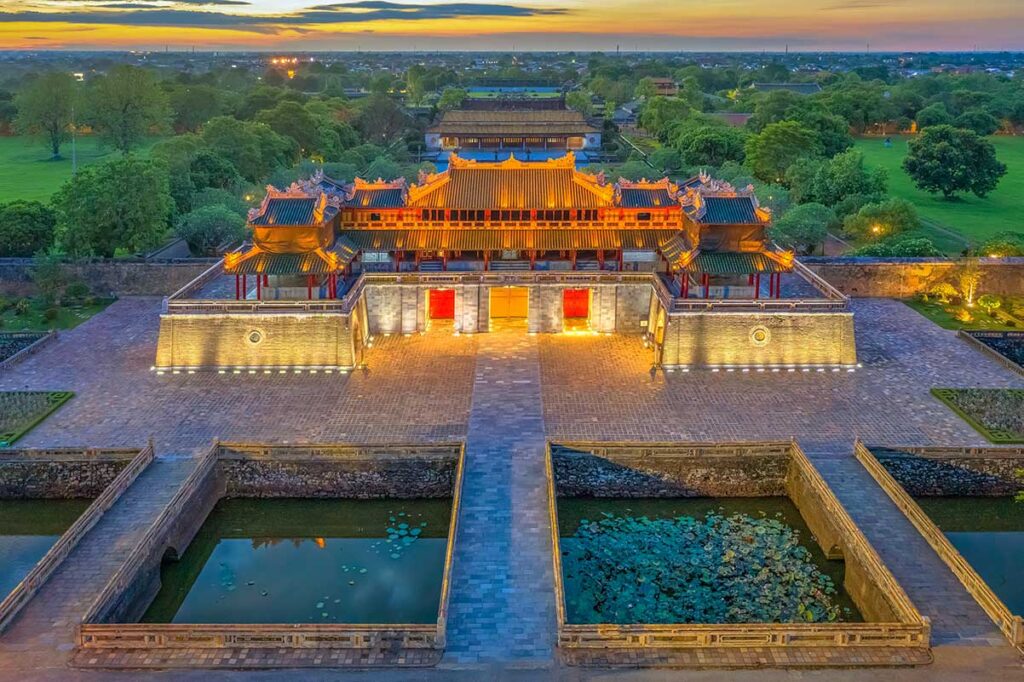
The Hue Imperial City was constructed in the early 19th century during the reign of Emperor Gia Long, and it served as the imperial capital of Vietnam for over a century. The Imperial City houses the Forbidden Purple City, where the royal family lived, along with various palaces, temples, and gates, all set within massive, defensive walls. The Citadel’s design was inspired by Chinese architecture, and it reflects Vietnam’s imperial grandeur.
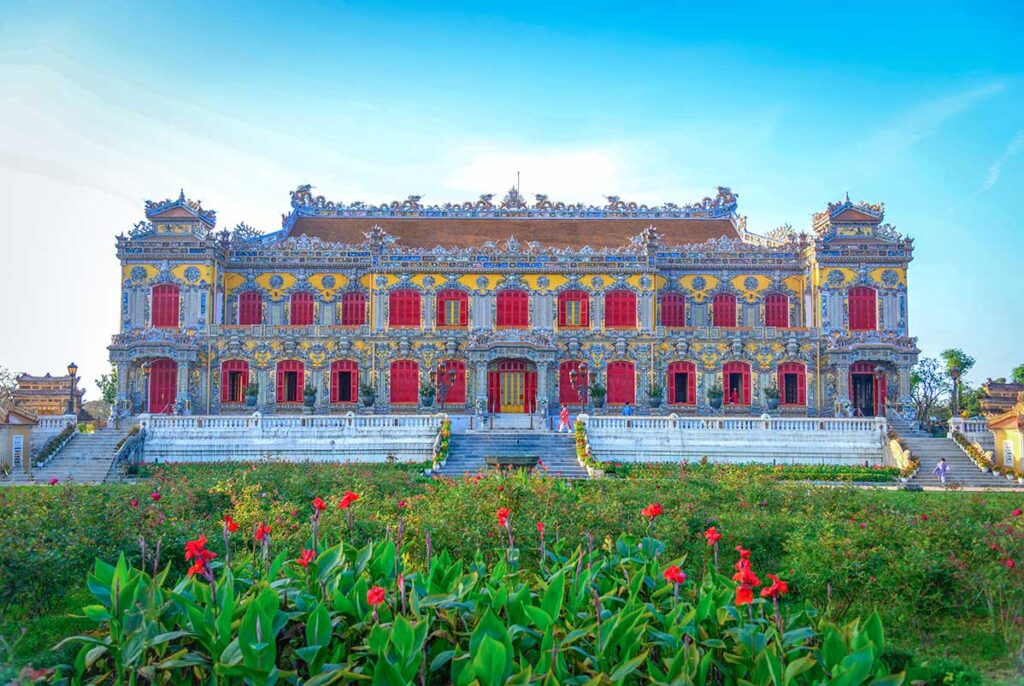
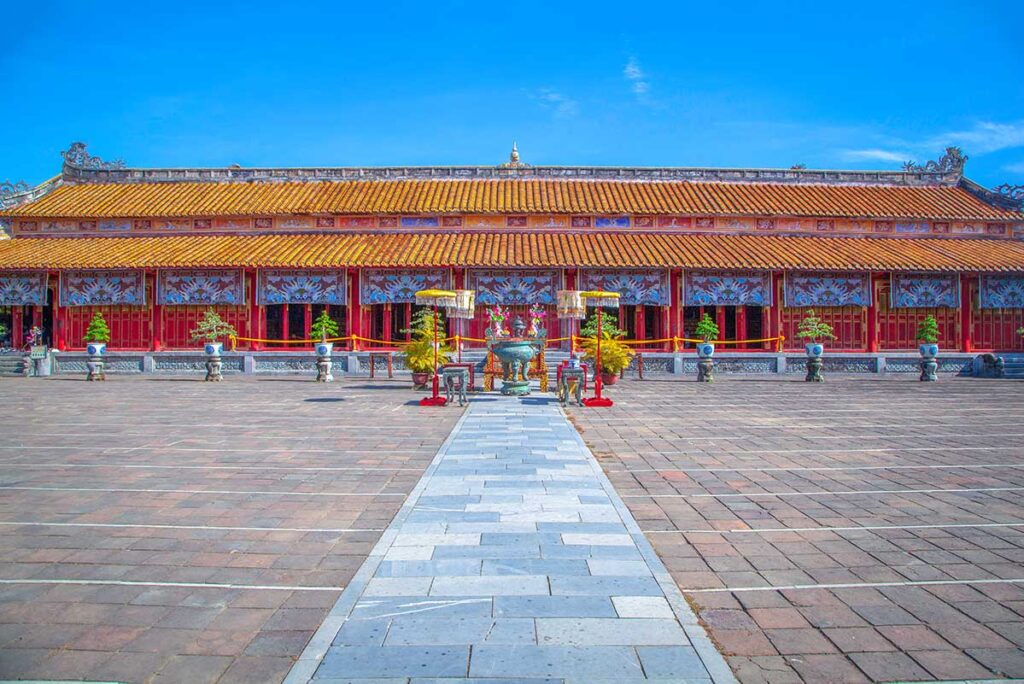
Today, the Hue Imperial Citadel remains one of the best-preserved examples of Vietnam’s royal past, offering visitors a chance to walk through history. With its grand scale and majestic buildings, it provides an unmatched view into Vietnam’s imperial life, making it an essential stop for anyone visiting Hue. The Imperial City’s combination of historical significance and architectural beauty makes it the top must-visit attraction in Hue.
2. Tu Duc Tomb –The Most Romantic Tomb in Hue
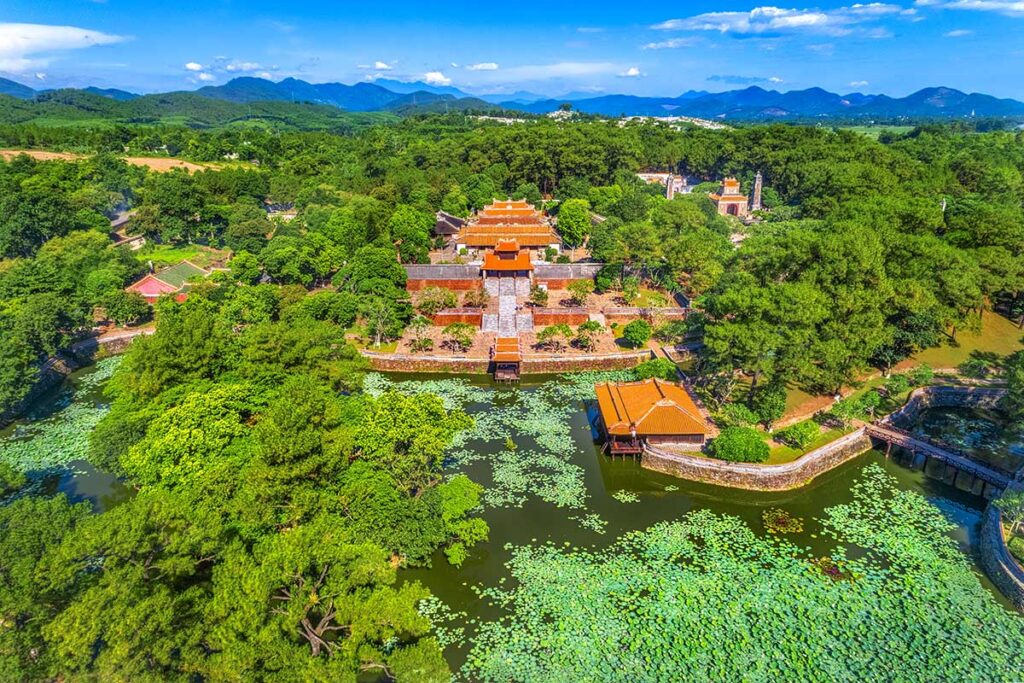
Tu Duc Tomb is one of the most beautiful royal tombs in Hue, completed in 1873 for Emperor Tu Duc, who ruled during a difficult period of Vietnam’s history. The tomb is known for its romantic setting, with lush gardens, a lake, and pavilions, all harmoniously integrated with the surrounding natural landscape. Tu Duc was a lover of poetry and art, and he designed his tomb to be a peaceful retreat where he could enjoy the beauty of nature.
What sets Tu Duc Tomb apart is its beautiful integration with nature and its serene atmosphere. The tomb’s location in a pine forest, combined with the natural lake and manicured gardens, makes it one of the most picturesque sites in Hue. It is a favorite for visitors who enjoy both history and scenic views, offering a calming and reflective experience.
3. Minh Mang Tomb – Hue’s Most Harmonious Royal Tomb

The Minh Mang Tomb, completed in 1843, is one of the largest and most stately tombs in Hue, built for the second emperor of the Nguyen Dynasty. Known for its strict symmetry and orderly design, the tomb reflects Emperor Minh Mang’s belief in Confucianism and his desire for order and harmony. The tomb features a series of elegant gates, courtyards, and lotus ponds, all carefully arranged to create a balanced, peaceful atmosphere.
The Minh Mang Tomb is often regarded as the most harmonious royal tomb due to its perfect symmetry and stunning natural surroundings. The peaceful ponds, the pine trees, and the meticulous layout make this site especially beautiful to visit. It’s perfect for those who appreciate not just the historical context but also the calming aesthetic of a well-planned, tranquil space.
4. Khai Dinh Tomb – The Most Unique and Ornate Tomb in Hue
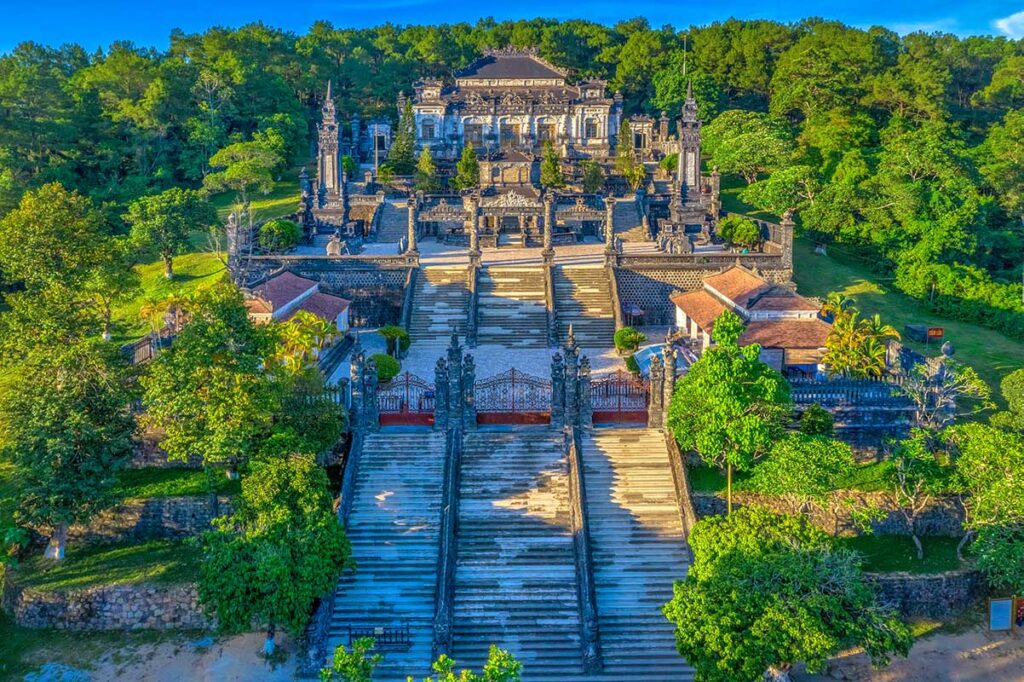
Khai Dinh Tomb was built for Emperor Khai Dinh, who ruled from 1916 to 1925, this tomb stands out for its fusion of Western and Eastern architectural styles, incorporating French, Vietnamese, and even Indian influences. The tomb is ornate and lavish, with intricate mosaics and paintings covering its walls and ceilings. The tomb’s design contrasts sharply with the more traditional tombs of earlier emperors, making it one of the most eccentric and eye-catching sites in Hue.
What makes Khai Dinh Tomb unique is its contrast of styles, combining traditional Vietnamese elements with European opulence. The mosaic interiors, made of millions of pieces of porcelain and glass, are among the most decorative and striking in Vietnam. Its mix of luxury and historical complexity makes it a fascinating stop for visitors interested in both history and art.
5. Thien Mu Pagoda – The Most Iconic Pagoda in Hue
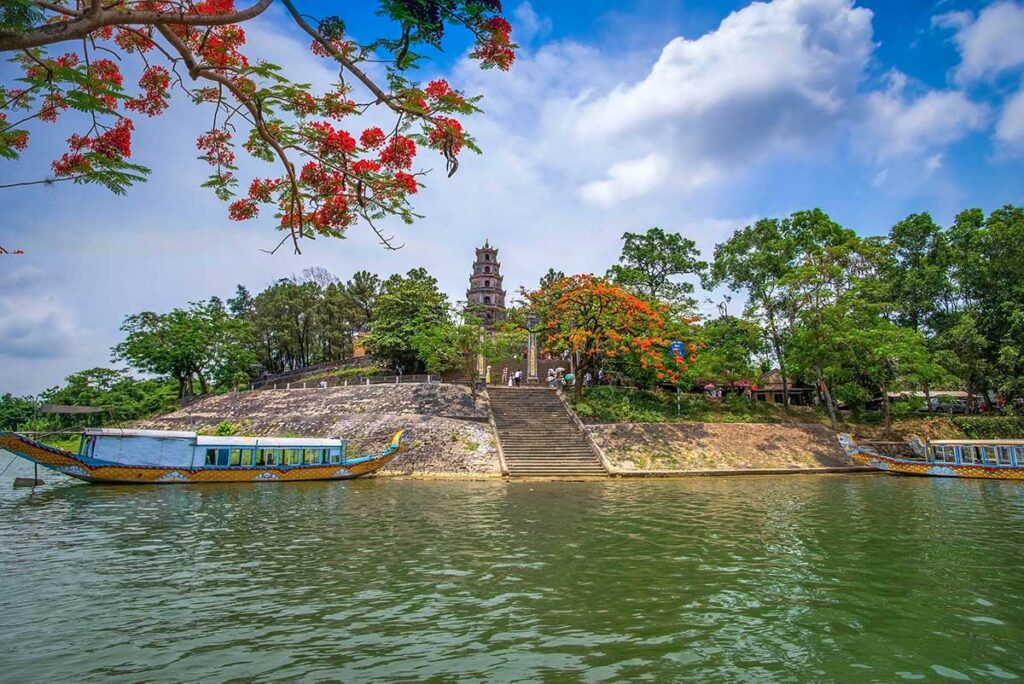
Thien Mu Pagoda, also known as the Pagoda of the Celestial Lady, is one of the oldest and most iconic pagodas in Vietnam. Built in 1601, it sits on a hill overlooking the Perfume River, providing panoramic views of Hue. The pagoda is known for its seven-tiered structure, which symbolizes the Buddhist concept of harmony between heaven and earth. The pagoda has also played a significant role in Vietnamese history, particularly during the anti-colonial struggles.
The Thien Mu Pagoda is a symbol of Hue and remains one of the most visited and revered religious sites in the city. Its serene atmosphere, scenic location, and historical significance make it the best pagoda in Hue to visit for anyone interested in Vietnamese culture and spirituality. Its peaceful surroundings and iconic architecture offer a tranquil experience.
6. Gia Long tomb – Best for Peaceful Scenery and Adventure

The Gia Long Tomb is the burial place of Emperor Gia Long, the first emperor of the Nguyen Dynasty. Located about 16 km from Hue, this tomb is more remote than others, offering a quieter, more adventurous visit. The tomb is spread out over a vast area, with lush gardens, pine forests, and overgrown graveyards, creating a mysterious and romantic atmosphere.
Gia Long Tomb is perfect for those seeking an off-the-beaten-path experience. The peaceful setting, scenic drive, and rural landscapes make it a memorable visit for adventurous travelers. Unlike the more crowded tombs in Hue, this one allows for a more intimate exploration of the emperor’s legacy, with fewer tourists around.
7. Ho Quyen Tiger Arena – Rare Glimpse into Royal Sports History
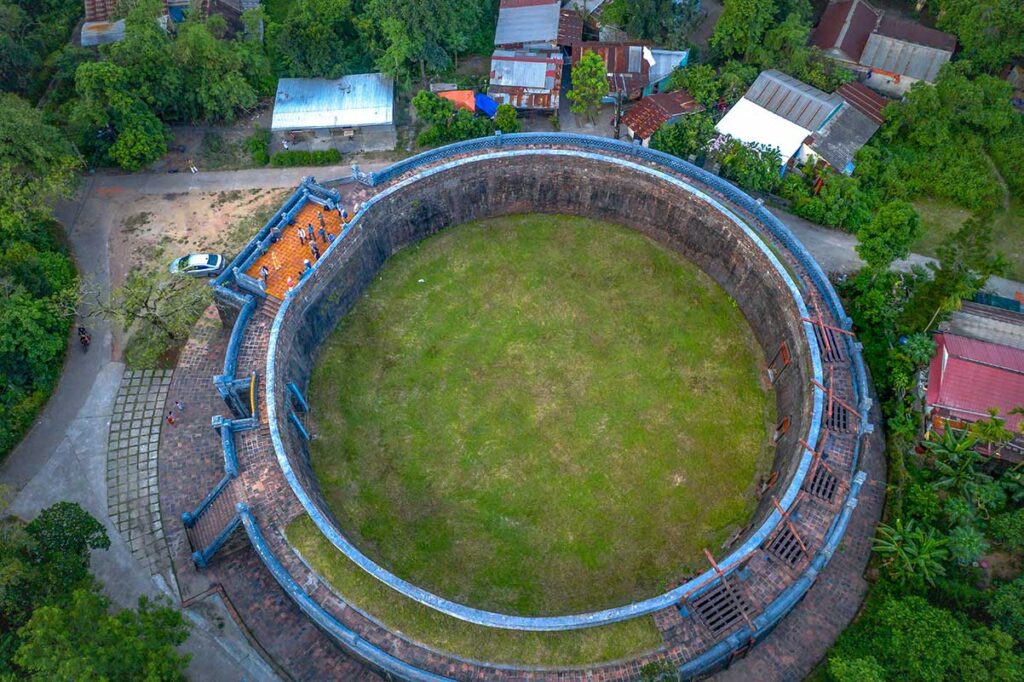
The Ho Quyen Tiger Arena is a unique historical site where tigers and elephants were once pitted against each other in royal spectacles for the entertainment of the emperor and his court. Built during the early 19th century, this arena was used for royal sport and also as a symbol of imperial power. Today, it stands as a rare glimpse into the royal entertainment of Vietnam’s past.
The Ho Quyen Tiger Arena is an unusual and fascinating site to visit, offering something different from the usual tombs and pagodas. Its historical significance, combined with the mystery of its use, makes it a must-see for history enthusiasts. It’s a site that stands out because of its cultural uniqueness in Hue.
8. Thieu Tri Tomb – Hue’s Quietest Royal Tomb

Thieu Tri Tomb is one of the least visited royal tombs in Hue, making it perfect for those who want to avoid the crowds. Built for Emperor Thieu Tri, the tomb is not as grand as others, but its calm atmosphere and well-preserved structure offer visitors a serene experience. The tomb features a simple but elegant layout, with a temple, crypt, and peaceful grounds.
What makes Thieu Tri Tomb special is its peaceful environment, offering a quiet respite from the more crowded royal tombs. The site’s understated beauty and calm surroundings make it ideal for travelers looking for a lesser-known yet still important site in Hue. It’s the perfect spot for visitors who prefer a more relaxed and reflective experience.
9. Thanh Toan Bridge – A Historic Covered Bridge Near the Rice Fields

The Thanh Toan Bridge is an 18th-century covered bridge located just outside of Hue, in a rural village. Known for its traditional wooden structure and quaint design, the bridge is a symbol of the village’s agricultural life and offers a unique contrast to the grand tombs and temples in the city. The bridge is still used by locals and offers visitors a glimpse into Hue’s rural heritage.
Although it’s not a tomb or pagoda, the Thanh Toan Bridge offers a charming and cultural experience that highlights the traditional architecture of the region. The bridge’s historical significance, along with its picturesque surroundings, make it an excellent stop for those looking to see a different side of Hue’s history.
10. Tu Hieu Pagoda – A Spiritual Pagoda Surrounded by Pine Trees
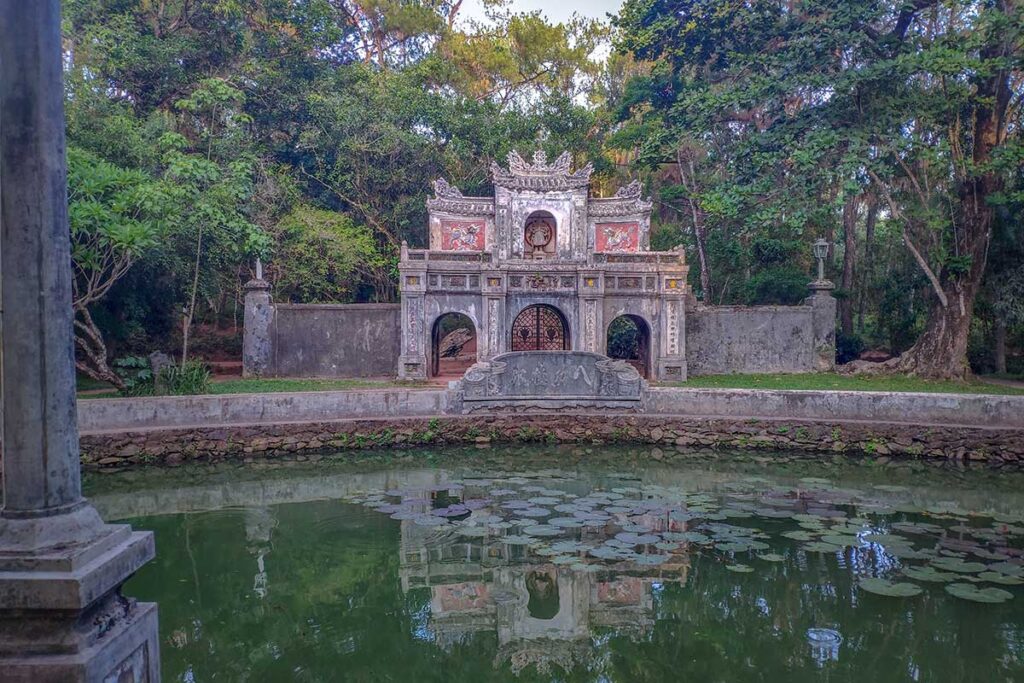
Located in a quiet, wooded area of Hue, Tu Hieu Pagoda is one of the most peaceful and spiritually significant pagodas in the region. The pagoda was built in the 17th century and has long been a place for meditation and spiritual reflection. Surrounded by tall pine trees and set near a small lake, it offers a serene environment for visitors to connect with nature and spirituality.
Tu Hieu Pagoda is perfect for those who seek a quiet, spiritual experience away from the more tourist-heavy sites. The pagoda’s simple beauty, combined with its peaceful setting and deep connection to Zen Buddhism, makes it an essential stop for those interested in Hue’s spiritual heritage.
